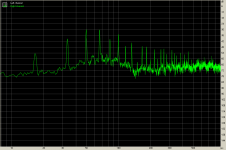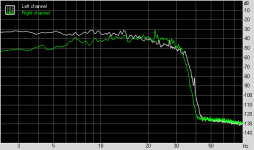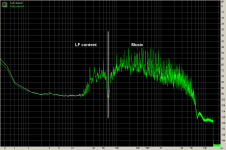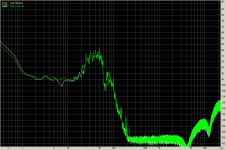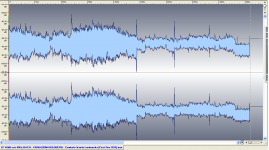Good work George. Last year when I was flying on a lot of turboprop aircraft, I did similar analysis. The main frequency and number of blades made the engine RPM obvious.
About a dozen years ago around Albuquerque the low frequency content of the V-22 Osprey helicopter made it obvious something different was in the air. Funny thing, it flew so high I didn't realize how big the thing is until years later.The main frequency and number of blades made the engine RPM obvious.
Using the formula George just posted, Blade Pass Frequency (BPF)=main rotor’s RPM x No of blades / 60, after some research finding the Osprey's rotation of 332 RPM puts the BPF at 16.6 Hz.
A real gut (and house) shaker, sorry no recordings, the Osprey flys fast!
Art
after some research finding the Osprey's rotation of 332 RPM puts the BPF at 16.6 Hz.
A real gut (and house) shaker, sorry no recordings, the Osprey flys fast!
Art
Spot on! Matches the signature up to 29th harmonic (482Hz) (recording from inside the cockpit)
George
Attachments
It wouldn't take long for me to feel queasy in the Osprey cockpit, the 16.6 Hz made me uneasy when it was a mile above!
I pulled off the freeway to try to identify the "UFO" first time I heard it.
Kind of surprised to see the 3rd & 4th harmonics 24 dB above the fundamental, guess that's why some have described it's sound as a "hum" compared to other 'copters "whop-whop" prop noise.
I wonder how low the intro to Yanni's "Sphynx" is (it has a synth helicopter sound), IIRC the fundamental could be seen on fast LED meters on some live shows we did back in the "Chameleon Days", shook things up- the analog BSS crossovers we used back then had only a 20 Hz HP on a >< 55 Hz Fc FLH, or >< 40 Hz Fb BR!
Art
I pulled off the freeway to try to identify the "UFO" first time I heard it.
Kind of surprised to see the 3rd & 4th harmonics 24 dB above the fundamental, guess that's why some have described it's sound as a "hum" compared to other 'copters "whop-whop" prop noise.
I wonder how low the intro to Yanni's "Sphynx" is (it has a synth helicopter sound), IIRC the fundamental could be seen on fast LED meters on some live shows we did back in the "Chameleon Days", shook things up- the analog BSS crossovers we used back then had only a 20 Hz HP on a >< 55 Hz Fc FLH, or >< 40 Hz Fb BR!
Art
Last edited:
Kind of surprised to see the 3rd & 4th harmonics 24 dB above the fundamental
This is due to the high HP of the recording!
On the power spectrum, the fundamental should have been 10-15dB above the 2nd harmonic and the 2nd some 6-8 db above 3rd, although the balance btn even and odd harmonics greatly depends on the (variable) blade angle
In the cockpit the sound is more like a “buzz”.
You don’t perceive the LF fundamental, the higher harmonics dominate (Fletcher Munson curve).
With distance increasing, the higher harmonics attenuate more than the lower, leaving the 3-4 lowest dominating the acoustic impression on the far distance (ground).
Rotor wing pilot’s physical and mental fatigue from vibration and LF sound is a known issue (the main cause for vehicle’s structural fatigue as well)
I checked Yanni's "Sphynx" synth helicopter sound.
It has weak only 12.5 and 14.5Hz (-70dBFS) components and strong 45Hz (-40dBFS) and 90Hz (-27dBFS) components spread across 5-10Hz respectively, thus your “pumping sound” remembering
George
My upstairs system has flat in room response to 24 hz. My living room system goes to 50hz. There are a few songs that go to 30hz on the RTA. The songs with 30hz sound much better to me on the upstairs system they rattle the whole house.
Deep bass is easy to build, if a person has the time, money and wants such a system they should build it.
The AE TD15S or H does covers the range well and with a little efficiency too.
Deep bass is easy to build, if a person has the time, money and wants such a system they should build it.
The AE TD15S or H does covers the range well and with a little efficiency too.
On Wanda Landowska's Goldberg Variations you can hear the 6th Ave Subway rumble through... originally on 78s*. The rumblings get clearer as my bass improves, decade by decade and never noticed around maybe 1960. It is said there are other ancient recordings made in that (?) studio with the subway showing up at regular intervals. Pity the NYC subway runs all night.
B.
*she died in 1959
B.
*she died in 1959
Last edited:
Likely. Can't say for sure. Possibly elves have removed the rumble in later issues.Is it the RCA VICTOR DM 1022 ?
My old vinyl disks are living (happily, no doubt) in Japan or somewhere. Didn't database the info as I committed the recording to Morse code.
Like any old friend, I retain an attachment to the performance. But her expressive style and the King Kong harpsichord aren't in favour today. At least it ain't on the piano!
B.
Last edited:
For the comrades who (physically) live away from their classic 78 & 33 rpm collections.
SERIOSO SERIOSO
- YouTube
🙂
George
SERIOSO SERIOSO
- YouTube
🙂
George
Last year after the Hurricane we had a group of 4 Ospry choppers fly over the house fairly close, maybe 1500 ft. The bass was amazing! Before I could actually hear what they were, it was just a powerful rumble. It wasn't until they got into sight that the harmonics were audible. Sure wish I could have recorded it.
I have recorded a few recent thunderstorms. Peak energy there is about 125Hz, which is high than I thought, but agrees with some studies I've read.
I have recorded a few recent thunderstorms. Peak energy there is about 125Hz, which is high than I thought, but agrees with some studies I've read.
Royal Concert Hall, Glasgow
Bill has kindly shared two tracks from recordings done at Royal Concert Hall in Glasgow, before and after the renovation. Thanks Bill.
I've spent a lazy Sunday morning listening to, looking at and analyzing the 2 tracks. There is definitely some good rumble on both, though the two sound slightly different to the ear. The Fucik recording has a large amount of out of phase rumble below 40Hz which is easy to hear on headphones, see on an X/Y graph, or cancel out with software. The Adams recording as a similar rumble, but more in phase than the other recording. Likely just mics and mixing differences.
Listening to the tracks with a steep low pass filter at 40Hz reveals almost no music down there. Almost. The Fucik piece has strong bass drums hits at 28Hz, but nothing else. The Adams has some low notes just audible sub 40 Hz. The rest is rumble that seems to have no correlation with the music, no rhythm, nothing cyclical. At least that I can hear. It's just noise.
Low passed at 32Hz, it's about the same, with everything but the bass drum and the rumble gone. mixed to mono the rumble in the two recordings is similar to the ear, and looks similar on an FFT plot, but the waveforms don't look much alike. Not sure what to make of that.
Attached is a plot of just the mono rumble below 32Hz with the post renovation recording on the left channel.
Bill has kindly shared two tracks from recordings done at Royal Concert Hall in Glasgow, before and after the renovation. Thanks Bill.
I've spent a lazy Sunday morning listening to, looking at and analyzing the 2 tracks. There is definitely some good rumble on both, though the two sound slightly different to the ear. The Fucik recording has a large amount of out of phase rumble below 40Hz which is easy to hear on headphones, see on an X/Y graph, or cancel out with software. The Adams recording as a similar rumble, but more in phase than the other recording. Likely just mics and mixing differences.
Listening to the tracks with a steep low pass filter at 40Hz reveals almost no music down there. Almost. The Fucik piece has strong bass drums hits at 28Hz, but nothing else. The Adams has some low notes just audible sub 40 Hz. The rest is rumble that seems to have no correlation with the music, no rhythm, nothing cyclical. At least that I can hear. It's just noise.
Low passed at 32Hz, it's about the same, with everything but the bass drum and the rumble gone. mixed to mono the rumble in the two recordings is similar to the ear, and looks similar on an FFT plot, but the waveforms don't look much alike. Not sure what to make of that.
Attached is a plot of just the mono rumble below 32Hz with the post renovation recording on the left channel.
Attachments
Google sent me to a site called "extraneous noises on recordings". All kinds of fun stuff from anti-aircraft guns in Paris to subways in NYC.
Google Groups
Isolating a concert hall or recording studio from the outside world is very hard. I worked on Roy Thomson Hall and it was a major issue how to "float" the inner hall. Even isolation from patron noise on balconies, HVAC, ambulances on the street.... (Not related to my role on the project except that isolation techniques tend to be indirectly user-unfriendly.)
B.
Google Groups
Isolating a concert hall or recording studio from the outside world is very hard. I worked on Roy Thomson Hall and it was a major issue how to "float" the inner hall. Even isolation from patron noise on balconies, HVAC, ambulances on the street.... (Not related to my role on the project except that isolation techniques tend to be indirectly user-unfriendly.)
B.
Yes, it's a big problem. I worked at the new Opera de la Bastille when it opened. There were major efforts undertaken to decouple the concert hall from the Paris Metro and from the scene shops at the back. Largely successful, as I remember.
Many modern recordings sound bad even at "6", a friend of mine came by to have a listen, he had some tunes he wanted to try out, some of the tunes he agreed wholeheartedly that it was just completely intolerable a more than medium volume, bass was non existent, video was cool though. Must have been aimed squarely at phone and laptop speakers...
I agree with your comment on modern recordings. You are likely describing the result of "dynamic range compression".
A (bad) necessity in the modern day "loudness war".
I also agree that it was mixed for I-phone and laptop speakers...........and lets not forget car audio (likely where it started in the late 80's through early 90's, (with both radio and CD).
There is some modern music available (very little) that has not been squashed in the engineering room. My experience is, if you want to enjoy music at a prolonged loud level (+90db?) and have it sound dynamic and live, with very little fatigue, you can generally pick any content tracked and mastered before 1990 (roughly).
Beware of the term "remastered"!
They often squash the dynamics for playback on todays modern devices, giving the middle finger to home stereo/hifi guys 😡.
One of the most dynamic, best sounding (loud) live recordings I own, is an old CD I purchased used for $6. 🙂.
Are you sure about that? I mean have you measured? I don't doubt the prodigious bass of DubStep clubs, or even live PA. Been in the biz over 40 years and I know it has to be super loud to be felt. My question would be, is there really much content below 30Hz in this music. I have't been able to find it, but if you know where it is, I'm happy to look.
Second question would be: When the bass is really rolling, really giving you that club feeling, what is the frequency range?
As far as the second question-
My experience with "the club feeling" is not so much the gut rumbling (20-30Hz) as it is the the mid bass punch, with the fundamental being right around 80Hz.
That's exactly how I've described it in the past. So, for music it doesn't need to go particularly low, but for an accurate reproduction of the event, it does.
Yes Iv'e noticed this experience.
Even just a vocalist sounding more "live" with a good set of subs vs. without.
Thanks Pano, I wasn't going mad. I'll drop Chandos an email and ask why it's there. Would be interesting to find out how that got through mastering as I would have though they would have checked for that.
Hope you liked the recordings as well? I think they are one of the best of the current UK labels.
Hope you liked the recordings as well? I think they are one of the best of the current UK labels.
Last edited:
On Wanda Landowska's Goldberg Variations you can hear the 6th Ave Subway rumble through... originally on 78s
YouTube
See the LF content.
Then I low passed (60Hz, 48dB/oct in Audacity) the playback and took a listen again. IMO, only mechanical noise.
Notice how the LF content changes with the change of 78rpm record.
George
Attachments
As an absolute bass freak (ex drummer and bassist) I fought for tight accurate and low bass for years.
I never felt like I got it right until I went to a conference about room interaction.
Now with bass traps in all 4 corners top to bottom and 4 active subs I am finally satisfied.
The room is just as much a part of the equation as is you low frequency target.
My experience says the room is a MORE important equasion than a ULF target.
Also agree 100% that both room treatments and multiple subs are where to start (and perhaps stop) before doting on ULFE!!
- Status
- Not open for further replies.
- Home
- Loudspeakers
- Subwoofers
- Realistically, how low is bass in music?
